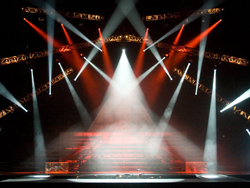
Recently, I was hired to program a live television special. The LD hired me because we have worked together before and he knows that I will come to the event and simply do my job. I have learned from my experiences not to wait for him on every detail of the show. He knows I will create original looks that fit with his style and work for the television camera.
In fact, he even told me that he is not worried about what patterns are in the fixtures, as he knows that I will “work my magic and create new visual images.” If I had only programmed one or two shows in my life, he would not have wanted to hire me for this production.
There is an extremely short amount of time from load in to taping, and he has no time to sit with a programmer to describe every bit of the show. So do not be in a hurry to jump into the “big shows.” Instead, take your time and work hard, and the large productions will come to you. You will learn more about lighting on every production you are involved with and you should enjoy all the new challenges.
Creativity And Consistency
Usually lighting programmers are hired not only to assist in the creation and storage of an LD’s vision, but also to share in the creative process. It is extremely important that an automated lighting programmer is both left- and right-brained. It is often said that one side of the brain is technical and the other creative.
A programmer must be able to derive original looks, concepts, chases, and then utilize the tools at hand to bring these ideas to life. Whether you are a highly creative person or not, there are many books and exercises on the subject of creativity. I strongly recommend exercising your brain as much as possible.
The technical side of a programmer’s brain must contain the data needed to properly use a console and fixtures. In addition, regular, consistent routines should be used in console setup.
For example, if you always number your colors or positions in a particular order, then no matter what show or console you are using, you will know that color 3 position 5 equals “down center stage red.” Do not just randomly lay out your console with each show. Of course, there will be aspects specific to each production, but if your basic building blocks are the same, then your programming will be much faster and efficient.
Learning To Program
Once, while I was in Tokyo, Japan enjoying fine food with friends, we discussed the puffer fish (fugu). If the puffer fish is not properly prepared,
then it can lead to tetrodotoxin poisoning, which has a 50 percent mortality rate. In Japan, only specially licensed sushi chefs are allowed to prepare and serve this dish.
In fact, the U.S. Food and Drug Administration (FDA) allows properly prepared portions of the puffer fish into the United States only two to three times a year. The FDA’s agreement with Japan states, “Experience has shown that the best method for obtaining a product which will not cause illness or death is the highly specialized training and knowledge for product preparation.”
Although an extreme analogy, automated lighting also should not be taken lightly.
Luckily, the mortality rate for improper programming of automated lights is extremely small—although I know some LDs who have wanted to kill their programmers! However, lighting programmers must practice their craft and continue to learn. Consoles are always improving, new fixtures are released, and creative visions change. There are many resources to help you learn how to program, but practice makes perfect.
